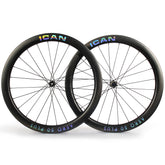Grip more important than speed: How lowering tire pressure improves control in the rain
Riding in the rain can be difficult for racing cyclists. While riding in wet weather will keep you in shape all year round, it's worth making slight adjustments to your setup compared to dry conditions. The key to these adjustments is to properly lower tire pressure to improve traction on slippery roads.
There is a common misconception that higher pressure means faster rolling. However, the most efficient setup depends on the conditions. On a sunny day, inflated tires cut through the asphalt with minimal rolling resistance. But rain turns asphalt into a less predictable surface. Lower pressure means wider contact patches, so more rubber hits the road.

As a general guideline, in wet weather you should reduce pressure by 10% (approx. 5-10 psi) from your usual pressure value. Too little and there is a risk of bruising from hitting the rim. Too much, and you lose the valuable grip you need to maintain control in corners and braking zones. The goal is to find the sweet spot where the tires conform to the textured terrain below without bottoming out. Accuracy of tire pressure is really important here as hard tires bounce and slide much more easily than tires with a little more give. Lower pressure bike tires have more grip, and that extra grip will be crucial.
On racing bikes, the weight distribution between the front and rear wheels is typically uneven. This distribution varies depending on the riding position of the rider and the bike, but in general the rear wheel supports slightly more weight than the front wheel. To balance this weight distribution, it is recommended to apply slightly less air pressure to the front tire than to the rear tire. A good rule of thumb is to put a few psi less on the front tire.
The optimal tire pressure varies depending on the weight of the rider and the possible load on his bike. For heavier drivers or load carriers, tire pressure should be higher, while lighter drivers need lower pressure.
When using tubeless tires, it is important to note that you can easily run lower pressures without the risk of a tube pinch due to the lack of a tube. Using tubeless tires can be particularly beneficial for off-road grip, especially if you ride a road bike with relatively large tires and plan to do light off-road or gravel riding.

Modern clincher tires offer tread patterns suitable for mixed conditions. The file-style tread remains sufficiently fast-rolling, but small nubs still dig into the accumulating water. Wider tires also have more contact with the surface, allowing them to glide over bumps in the road. By using tubeless, puncture protection with self-healing powers is increased even further.
For safety reasons, special caution is required on the road when it rains. Brake earlier and more gently to avoid slipping. Slow down when cornering and watch out for slippery manhole covers or metal grates. Keep enough space between you and the vehicles in front as the braking distance is doubled. Consider postponing the trip entirely if a heavy downpour reduces visibility.

With the right tire setup and riding settings, cycling in wet weather doesn't have to be limited. Simply reduce pressure, double-check your brakes and drive within your limits on rain-soaked roads. Because tires lose air over time, you should check and adjust tire pressure every two weeks or at least once a month. A little preparation goes a long way toward enjoying drizzly rides responsibly.





